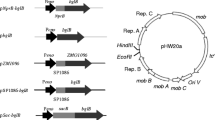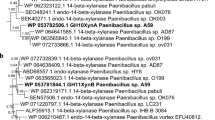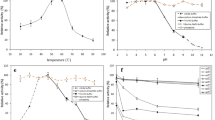Abstract
Recombinant Zymomonas mobilis (pGEX-4T-3 BI 120-2) was constructed to encode endo-glucanase (CelA) and endo-xylanase (Xyn11) from Z. mobilis ZM4 (ATCC 31821) and an uncultured bacterium. The recombinant was genetically engineered with the N-terminus of a predicted SecB-dependent (type II) secretion signal from phoC of Z. mobilis to translocate the enzymes extracellularly. Both the enzymes were characterized regarding their functional optimum pH and temperature, with the highest multi-enzyme activities at pH 6.0 and a temperature of 30 °C, which approximates the optimum conditions for ethanol production by Z. mobilis. The crude intracellular and extracellular fractions of the recombinant were characterized in terms of substrate specificity using carboxymethyl cellulose (CMC), beechwood xylan, filter paper, Avicel, and pretreated rice straw. The crude extracellular and intracellular enzymes with cellulolytic and xylanolytic activities were more robustly produced and secreted from the recombinant strain compared to the wild-type and ampicillin-sensitive strains, using CMC and beechwood xylan as the substrates. Ethanol production by the recombinant strain was greater than the production by the wild-type strain when pretreated rice straw was used as a sole carbon source.





Similar content being viewed by others
References
Lynd, L. R., Weimer, P. J., Van Zyl, W. H., & Pretorius, I. S. (2002). Microbial cellulose utilization: fundamentals and biotechnology. Microbiology and Molecular Biology Reviews, 66(3), 506–577.
Lynd, L. R., Van Zyl, W. H., McBride, J. E., & Laser, M. (2005). Consolidated bioprocessing of cellulosic biomass: an update. Current Opinion in Biotechnology, 16(5), 577–583.
Carere, C. R., Sparling, R., Cicek, N., & Levin, D. B. (2008). Third generation biofuels via direct cellulose fermentation. International Journal of Molecular Sciences, 9(7), 1342–1360.
Antoni, D., Zverlov, V. V., & Schwarz, W. H. (2007). Biofuels from microbes. Applied Microbiology and Biotechnology, 77(1), 23–35.
Todhanakasem, T., Sangsutthiseree, A., Areerat, K., Young, G. M., & Thanonkeo, P. (2014). Biofilm production by Zymomonas mobilis enhances ethanol production and tolerance to toxic inhibitors from rice bran hydrolysate. New Biotechnology, 31, 451–459.
Olofsson, K., Bertilsson, M., & Lidén, G. (2008). A short review on SSF—an interesting process option for ethanol production from lignocellulosic feedstocks. Biotechnology for Biofuels, 1(1), 7.
Sun, Y., & Cheng, J. (2002). Hydrolysis of lignocellulosic materials for ethanol production: a review. Bioresource Technology, 83(1), 1–11.
Rogers, P. L., Jeon, Y. J., Lee, K. J., & Lawford, H. G. (2007). Zymomonas mobilis for fuel ethanol and higher value products. In Biofuels (pp. 263–288). Berlin, Heidelberg: Springer.
Swings, J., & De Ley, J. (1977). The biology of Zymomonas. Bacteriological Reviews, 41, 1.
Zhang, M., Eddy, C., Deanda, K., Finkelstein, M., & Picataggio, S. (1995). Metabolic engineering of a pentose metabolism pathway in ethanologenic Zymomonas mobilis. Science, 267(5195), 240–243.
Zhang, M., Franden, M., Newman, M., McMillan, J., Finkelstein, M., & Picataggio, S. (1995). Promising ethanologens for xylose fermentation. Applied Biochemistry and Biotechnology, 51, 527–536.
He, M. X., Wu, B., Qin, H., Ruan, Z. Y., Tan, F. R., Wang, J. L., Shui, Z. X., Dai, L. C., Zhu, Q. L., & Pan, K. (2014). Zymomonas mobilis: a novel platform for future biorefineries. Biotechnology for Biofuels, 7, 101.
Polizeli, M., Rizzatti, A., Monti, R., Terenzi, H., Jorge, J. A., & Amorim, D. (2005). Xylanases from fungi: properties and industrial applications. Applied Microbiology and Biotechnology, 67(5), 577–591.
Dodd, D., & Cann, I. K. (2009). Enzymatic deconstruction of xylan for biofuel production. GCB Bioenergy, 1(1), 2–17.
Sanchez, O. J., & Cardona, C. A. (2008). Trends in biotechnological production of fuel ethanol from different feedstocks. Bioresource Technology, 99(13), 5270–5295.
Linger, J. G., Adney, W. S., & Darzins, A. (2010). Heterologous expression and extracellular secretion of cellulolytic enzymes by Zymomonas mobilis. Applied and Environmental Microbiology, 76, 6360–6369.
Kojima, M., Okamoto, K., & Yanase, H. (2013). Direct ethanol production from cellulosic materials by Zymobacter palmae carrying Cellulomonas endoglucanase and Ruminococcus β-glucosidase genes. Applied Microbiology and Biotechnology, 97, 5137–5147.
Luo, Z., & Bao, J. (2015). Secretive expression of heterologous β-glucosidase in Zymomonas mobilis. Bioresources and Bioprocessing, 2, 1–6.
Seo, J.-S., Chong, H., Park, H. S., Yoon, K.-O., Jung, C., Kim, J. J., Hong, J. H., Kim, H., Kim, J.-H., & Kil, J.-I. (2005). The genome sequence of the ethanologenic bacterium Zymomonas mobilis ZM4. Nature Biotechnology, 23(1), 63–68.
Rajnish, K., Choudhary, G. K., & Gunasekaran, P. (2008). Functional characterization of a putative endoglucanase gene in the genome of Zymomonas mobilis. Biotechnology Letters, 30(8), 1461–1467.
Amann, R. I., Ludwig, W., & Schleifer, K.-H. (1995). Phylogenetic identification and in situ detection of individual microbial cells without cultivation. Microbiological Reviews, 59(1), 143–169.
Todhanakasem, T., & Jittjang, S. (2016). Evaluation of cellulase production by Zymomonas mobilis. BioResources, 12, 1165–1178.
Stokes, H., Dally, E., Yablonsky, M., & Eveleigh, D. (1983). Comparison of plasmids in strains of Zymomonas mobilis. Plasmid, 9(2), 138–146.
Cao, Q.-H., Shao, H.-H., Qiu, H., Li, T., Zhang, Y.-Z., & Tan, X.-M. (2017). Using the CRISPR/Cas9 system to eliminate native plasmids of Zymomonas mobilis ZM4. Bioscience, Biotechnology, and Biochemistry, 81(3), 453–459.
Cao, Q., Li, T., Shao, H., Tan, X., & Zhang, Y. (2016). Three new shuttle vectors for heterologous expression in Zymomonas mobilis. Electronic Journal of Biotechnology, 19, 33–40.
Kanokratana, P., Eurwilaichitr, L., Pootanakit, K., & Champreda, V. (2015). Identification of glycosyl hydrolases from a metagenomic library of microflora in sugarcane bagasse collection site and their cooperative action on cellulose degradation. Journal of Bioscience and Bioengineering, 119(4), 384–391.
Yanase, H., Kotani, T., & Tonomura, K. (1986). Transformation of Zymomonas mobilis with plasmid DNA. Agricultural and Biological Chemistry, 50, 3139–3144.
Sandkvist, M. (2001). Biology of type II secretion. Molecular Microbiology, 40(2), 271–283.
König, J., Grasser, R., Pikor, H., & Vogel, K. (2002). Determination of xylanase, ß-glucanase, and cellulase activity. Analytical and Bioanalytical Chemistry, 374(1), 80–87.
King, F. G., & Hossain, M. A. (1982). The effect of temperature, pH, and initial glucose concentration on the kinetics of ethanol production by Zymomonas mobilis in batch fermentation. Biotechnology Letters, 4(8), 531–536.
Yanase, H., Nozaki, K., & Okamoto, K. (2005). Ethanol production from cellulosic materials by genetically engineered Zymomonas mobilis. Biotechnology Letters, 27(4), 259–263.
Imman, S., Arnthong, J., Burapatana, V., Laosiripojana, N., & Champreda, V. (2013). Autohydrolysis of tropical agricultural residues by compressed liquid hot water pretreatment. Applied Biochemistry and Biotechnology, 170(8), 1982–1995.
Acknowledgments
This work was financially supported by an Assumption University Research Grant (RP 59-002), Thailand.
Funding
The Z. mobilis ZM4 (NRRL B-14023) used in this study was obtained from Professor Pornthap Thanonkeo, Khon Kaen University, Thailand.
Author information
Authors and Affiliations
Corresponding author
Ethics declarations
Conflict of Interest
The authors declare that they have no conflict of interest.
Rights and permissions
About this article
Cite this article
Todhanakasem, T., Sowatad, A., Kanokratana, P. et al. Expression and Extracellular Secretion of Endo-glucanase and Xylanase by Zymomonas mobilis. Appl Biochem Biotechnol 187, 239–252 (2019). https://doi.org/10.1007/s12010-018-2821-4
Received:
Accepted:
Published:
Issue Date:
DOI: https://doi.org/10.1007/s12010-018-2821-4




